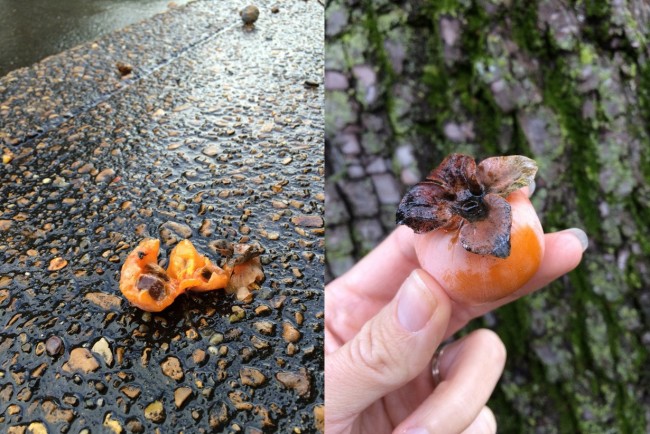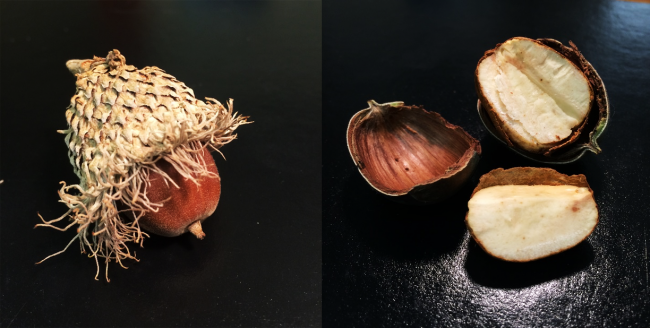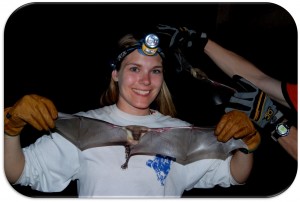Eat the trees!
In this guest blog, Sara Samoray describes several edible fruits and nuts that can be found in the arboretum during the fall.
What is that smooshy orange thing I just stepped on? Chances are, if you are walking in front of Branscomb Quad, that unpleasant looking orange mass is a tasty persimmon (Diospyros virginiana). This is a fruit that you actually want to pick off the ground instead of fresh from the tree. You may do a quick taste comparison between fresh and fallen fruits, or have a friend try the fresh-picked fruit for you, stand back, and watch the response. Persimmons have a strongly astringent, tannic taste when they are not quite ripe. This is the seed’s way of donning a protective jacket of disgusting orange flesh until it fully matures, and later the fruit’s flesh loses all bitterness and transforms into super sweet succulence whose taste can be likened to that of dates. The generic name, Diospyros, is derived from Greek meaning “divine fruit of the god Zeus.”

Scan the ground under the tree for fallen fruits that are not broken. They should be slightly squishy but not so ripe that they begin to ferment. Do you notice the smell of alcohol underneath this tree? Start by taking a small bite of the fruit which is very rich and eat around or spit out the seeds. Persimmons are used in making bread and jams but are a great little snack right off the ground as well.
Another snack item you can pick off the sidewalk is the black walnut (Juglans nigra), and for this fruit, it’s easier to harvest the nuts whose fleshy outer hull has been broken by someone stepping on it. You can break off the hull as well, but be careful because the same stain that makes furniture beautiful will also stain your hands. Allow the hulled nut to sit out in the sunshine for a couple of days, and make sure it is protected from squirrels. Squirrels will haul away bushels of nuts one-by-one in no time! After the nut has dried out a bit, smack it with a hammer to break the shell. An easy way to do this is to gather a bunch of walnuts in a sack and take out your aggression with a rubber mallet. Then, pick among the pieces with a nut pick or small knife to reap your reward. Fresh walnuts are so much tastier than store-bought nuts and worth the effort of harvesting.
You can also eat acorns, but be sure to eat acorns only from members of the white oak tribe including the white oak (the Vanderbilt oak; Quercus alba), bur oak (Q. macrocarpa), and chestnut oak (Q. montana). Oaks in the red oak tribe contain higher concentrations of tannins which our palates and digestive systems cannot handle. (Tannins are bitter, and can be irritating or toxic in large quantities.) Acorns require a bit of prep work in order to make them tasty, but when nuts are abundant in a mast year like we’re having now, it’s fun to try. To prepare acorns for snacking, you must first boil them in water for a couple minutes to loosen the shells then crack and peel the shell. Place the shelled acorns into boiling water, boil 5 minutes, and then change the water. Repeat the boiling and water-changing process a couple more times to leach tannins from the nut meat. Finally, strain, chop, and roast the nuts to bring out their sweetness. Acorns add a nice, nutty crunchiness when tossed onto chili or pumpkin soup, or they can be ground and added to cornbread. You can even make acorn flour cookies; just share some with the squirrels.

You can find some of the tree species mentioned here at various places in the arboretum. Click on the link to go to the tree’s web page, which includes information for finding the tree:
persimmon (female):
black walnut:
near McTyeire Hall and the Round Wing
between Frist Hall and the central library
between North Hall and the Cohen Building (on Peabody campus)
white oak:
in front of Buttrick Hall on Library Lawn (has an incredible number of acorns this year!)
near College Halls at Kissam (the largest white oak in the arboretum)
by Kirkland Hall
near the Peabody Library
there are many more!!!
bur oak:
near Stevenson Center on Library Lawn
between Garland and Rand Halls (the Bicentennial Oak – one of the four largest trees on campus)
across from the Susan Gray entrance on Peabody Campus
chestnut oak:
There are no large chestnut oaks at Vanderbilt. However, they can be seen along the Ganier Ridge trail at Radnor Lake and on the ridges above Henry’s Hollow in Beaman Park.
————————————————————————————————————————————
 Sara Samoray graduated from Auburn University with a M.S. in Biology where she studied the ecology of bats. She studied Botany at MTSU where she helped with a project to identify all trees on campus. Sara currently teaches General Biology labs at Vanderbilt and pursues her interests in conservation of bats and medicinal/edible plants.
Sara Samoray graduated from Auburn University with a M.S. in Biology where she studied the ecology of bats. She studied Botany at MTSU where she helped with a project to identify all trees on campus. Sara currently teaches General Biology labs at Vanderbilt and pursues her interests in conservation of bats and medicinal/edible plants.